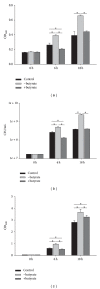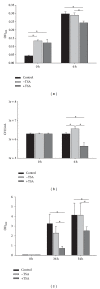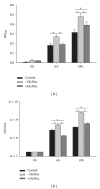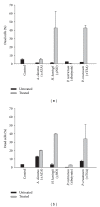Fungi treated with small chemicals exhibit increased antimicrobial activity against facultative bacterial and yeast pathogens
- PMID: 25121102
- PMCID: PMC4119895
- DOI: 10.1155/2014/540292
Fungi treated with small chemicals exhibit increased antimicrobial activity against facultative bacterial and yeast pathogens
Abstract
For decades, fungi have been the main source for the discovery of novel antimicrobial drugs. Recent sequencing efforts revealed a still high number of so far unknown "cryptic" secondary metabolites. The production of these metabolites is presumably epigenetically silenced under standard laboratory conditions. In this study, we investigated the effect of six small mass chemicals, of which some are known to act as epigenetic modulators, on the production of antimicrobial compounds in 54 spore forming fungi. The antimicrobial effect of fungal samples was tested against clinically facultative pathogens and multiresistant clinical isolates. In total, 30 samples of treated fungi belonging to six different genera reduced significantly growth of different test organisms compared to the untreated fungal sample (growth log reduction 0.3-4.3). For instance, the pellet of Penicillium restrictum grown in the presence of butyrate revealed significant higher antimicrobial activity against Staphylococcus (S.) aureus and multiresistant S. aureus strains and displayed no cytotoxicity against human cells, thus making it an ideal candidate for antimicrobial compound discovery. Our study shows that every presumable fungus, even well described fungi, has the potential to produce novel antimicrobial compounds and that our approach is capable of rapidly filling the pipeline for yet undiscovered antimicrobial substances.
Figures





Similar articles
-
Butyrate influences intracellular levels of adenine and adenine derivatives in the fungus Penicillium restrictum.Microbiol Res. 2017 Apr;197:1-8. doi: 10.1016/j.micres.2016.12.013. Epub 2017 Jan 11. Microbiol Res. 2017. PMID: 28219521
-
Differences in composition of honey samples and their impact on the antimicrobial activities against drug multiresistant bacteria and pathogenic fungi.Arch Med Res. 2013 May;44(4):307-16. doi: 10.1016/j.arcmed.2013.04.009. Epub 2013 May 15. Arch Med Res. 2013. PMID: 23684665
-
Antimicrobial activity of broccoli (Brassica oleracea var. italica) cultivar Avenger against pathogenic bacteria, phytopathogenic filamentous fungi and yeast.J Appl Microbiol. 2018 Jan;124(1):126-135. doi: 10.1111/jam.13629. Epub 2017 Dec 7. J Appl Microbiol. 2018. PMID: 29112318
-
Hybrid combinations containing natural products and antimicrobial drugs that interfere with bacterial and fungal biofilms.Phytomedicine. 2017 Dec 15;37:14-26. doi: 10.1016/j.phymed.2017.10.021. Epub 2017 Nov 23. Phytomedicine. 2017. PMID: 29174600 Review.
-
Underscoring interstrain variability and the impact of growth conditions on associated antimicrobial susceptibilities in preclinical testing of novel antimicrobial drugs.Crit Rev Microbiol. 2019 Feb;45(1):51-64. doi: 10.1080/1040841X.2018.1538934. Epub 2018 Dec 6. Crit Rev Microbiol. 2019. PMID: 30522365 Free PMC article. Review.
Cited by
-
Epigenetic Activation of Silent Biosynthetic Gene Clusters in Endophytic Fungi Using Small Molecular Modifiers.Front Microbiol. 2022 Feb 14;13:815008. doi: 10.3389/fmicb.2022.815008. eCollection 2022. Front Microbiol. 2022. PMID: 35237247 Free PMC article. Review.
-
Epigenetic Modifiers Induce Bioactive Phenolic Metabolites in the Marine-Derived Fungus Penicillium brevicompactum.Mar Drugs. 2018 Jul 30;16(8):253. doi: 10.3390/md16080253. Mar Drugs. 2018. PMID: 30061488 Free PMC article.
-
Effect of the Crude Extract of Coprophilous Fungi on Some Bacterial Species Isolated from Cases of Mastitis.Arch Razi Inst. 2021 Nov 30;76(5):1333-1341. doi: 10.22092/ari.2021.356366.1832. eCollection 2021 Nov. Arch Razi Inst. 2021. PMID: 35355757 Free PMC article.
-
Histone acetyltransferase TGF-1 regulates Trichoderma atroviride secondary metabolism and mycoparasitism.PLoS One. 2018 Apr 30;13(4):e0193872. doi: 10.1371/journal.pone.0193872. eCollection 2018. PLoS One. 2018. PMID: 29708970 Free PMC article.
-
Different histone deacetylase inhibitors reduce growth, virulence as well as changes in the morphology of the fungus Macrophomina phaseolina (Tassi) Goid.World J Microbiol Biotechnol. 2022 Feb 28;38(4):63. doi: 10.1007/s11274-022-03249-w. World J Microbiol Biotechnol. 2022. PMID: 35226232 English.
References
-
- Molinari G. Natural products in drug discovery: present status and perspectives. Advances in Experimental Medicine and Biology. 2009;655:13–27. - PubMed
-
- Taylor PW. Alternative natural sources for a new generation of antibacterial agents. International Journal of Antimicrobial Agents. 2013;42(3):195–201. - PubMed
-
- Winter JM, Behnken S, Hertweck C. Genomics-inspired discovery of natural products. Current Opinion in Chemical Biology. 2011;15(1):22–31. - PubMed
Publication types
MeSH terms
Substances
LinkOut - more resources
Full Text Sources
Other Literature Sources
Medical

